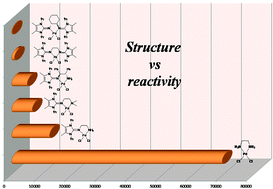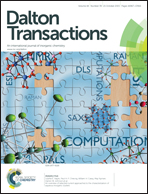Palladium(ii) complexes with highly basic imidazolin-2-imines and their reactivity toward small bio-molecules†
Abstract
A series of novel Pd(II) complexes with chelating mono(imidazolin-2-imine) and bis(imidazolin-2-imine) ligands were synthesized. The crystal structures of [Pd(DMEAImiPr)Cl2] and [Pd(DPENImiPr)Cl2] were determined by X-ray diffraction analysis. The reactivity of the six Pd(II) complexes, namely, [Pd(en)Cl2], [Pd(EAImiPr)Cl2], [Pd(DMEAImiPr)Cl2], [Pd(DPENImiPr)Cl2], [Pd(BLiPr)Cl2] and [Pd(DACH(ImiPr)2)Cl2], were investigated. Spectrophotometric acid–base titrations were performed to determine the pKa values of the coordinated water molecules in [Pd(en)(H2O)2]2+, [Pd(EAImiPr)(H2O)2]2+, [Pd(DMEAImiPr)(H2O)2]2+, [Pd(DPENImiPr)(H2O)2]2+, [Pd(BLiPr)(H2O)2]2+ and [Pd(DACH(ImiPr)2)(H2O)2]2+. The substitution of the chloride ligands in these complexes by TU, L-Met, L-His and Gly was studied under pseudo-first-order conditions as a function of the nucleophile concentration and temperature using stopped-flow techniques; the sulfur-donor nucleophiles have shown better reactivity than nitrogen-donor nucleophiles. The obtained results indicate that there is a clear correlation between the nature of the imidazolin-2-imine ligands and the acid–base characteristics and reactivity of the resulting Pd(II) complexes; the order of reactivity of the investigated Pd(II) complexes is: [Pd(en)Cl2] > [Pd(EAImiPr)Cl2] > [Pd(DMEAImiPr)Cl2] > [Pd(DPENImiPr)Cl2] > [Pd(BLiPr)Cl2] > [Pd(DACH(ImiPr)2)Cl2]. The solubility measurements revealed good solubility of the studied imidazolin-2-imine complexes in water, despite the fact that these Pd(II) complexes are neutral complexes. Based on the performed studies, three unusual features of the novel imidazolin-2-imine Pd(II) complexes are observed, that is, good solubility in water, very low reactivity and high pKa values. The coordination geometries around the palladium atoms are distorted square-planar; the [Pd(DMEAImiPr)Cl2] complex displays Pd–N distances of 2.013(2) and 2.076(2) Å, while the [Pd(DPENImiPr)Cl2] complex displays similar Pd–N distances of 2.034(4) and 2.038(3) Å. The studied systems are of interest because little is known about the substitution behavior of imidazolin-2-imine Pd(II) complexes with bio-molecules under physiological conditions.


 Please wait while we load your content...
Please wait while we load your content...